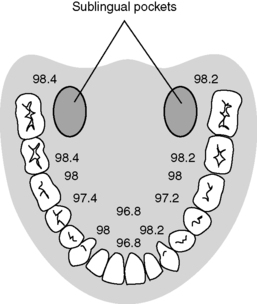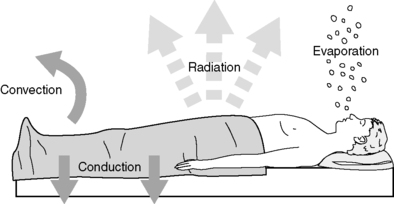CHAPTER 24. Thermoregulation
Vallire D. Hooper
OBJECTIVES
At the conclusion of this chapter, the reader will be able to:
1. Describe the physiology of thermoregulation.
2. Identify two complications of altered thermoregulation in the perianesthesia/perioperative setting.
3. Define unplanned perioperative hypothermia.
4. List three common causes of perioperative hypothermia.
5. Identify four adverse outcomes related to perioperative hypothermia.
6. Describe phase-specific recommendations for the management of perioperative hypothermia.
7. Define the pathophysiology of malignant hyperthermia (MH).
8. Identify the signs and symptoms of MH.
9. Describe the treatment of MH.
I. BASIC TERMS AND DEFINITIONS
A. Thermal compartments
1. Core thermal compartment
a. Well-perfused tissues with temperature remaining relatively uniform
b. Consists of organs of:
(1) Trunk
(2) Head
c. Comprises 50% to 60% of body mass
2. Peripheral thermal compartment
a. Consists of arms and legs
b. Temperature nonhomogeneous and varies over time
(1) Temperature usually 2° C to 4° C lower than core temperature
(2) Difference can be larger in more extreme thermal and/or physiological circumstances.
(a) Lower core-to-peripheral gradients
(i) Warm environment
(ii) Vasodilation in response to an increased metabolic heat (generated in the core)
(b) Higher core-to-peripheral gradients
(i) Cold environment
(ii) Vasoconstriction in an attempt to shift metabolic heat to the core
B. Temperature
1. Core temperature
a. Temperature of core thermal compartment
b. Most accurate core temperature measurement sites
(1) Pulmonary artery (PA)
(a) Obtained using a PA catheter
(b) Most accurate because the artery brings blood directly from the core and its surroundings
(c) Affected by:
(i) Large, rapid infusions of warmed or cold fluids
(ii) Respiratory cycles
(iii) Lower limb pneumatic compression devices
(2) Distal esophagus
(a) Best alternative to PA site
(b) Affected by:
(i) Active cooling phase of cardiopulmonary bypass
(ii) Surgery involving an open thorax or exposure of the diaphragm
(3) Nasopharynx
(a) Used to monitor brain temperature
(b) Not recommended with:
(i) Substantial anticoagulation
(ii) Manipulation of nasal mucosa
(4) Oral
(a) Temperature readings vary dependent on placement in oral cavity (Figure 24-1).
 |
| FIGURE 24-1
Temperature variations in the oral cavity.
(From Nicoll LH: Heat in motion: Evaluating and managing temperature. Nursing 32:s1-s12, 2002.)
|
(b) Accurate reflection of core temperature when taken in left or right posterior sublingual (buccal) pocket
(c) Site is dependable even in presence of:
(i) Oxygen therapy
(ii) Warmed and cooled inspired gases
(iii) Varied respiratory rates
(d) Do not use in patients who are:
(i) Disoriented
(ii) Shivering
(iii) Having seizures
c. Other temperature measurement sites used in the perianesthesia setting
(1) Tympanic membrane (Figure 24-2)
(a) Accuracy of reading dependent on:
(i) Operator technique
(ii) Patient anatomy
(iii) Accurate calibration
(iv) Inherent instrument error of instrument used
(b) Shown to be inaccurate to true core temperature measurements
 |
| FIGURE 24-2
Tympanic temperature monitoring.
(From Nicoll LH: Heat in motion: Evaluating and managing temperature. Nursing 32:s1-s12, 2002.)
|
(2) Temporal artery
(a) Favorably compares to tympanic and rectal measurements in children
(b) Less reliable in adults
(c) Lack of evidence to support accuracy to core temperature measurements in adults
(3) Axillary
(4) Bladder
(a) Subject to thermal lag in unsteady thermal states
(b) Continuous urinary drainage required
(c) Useful indicator of total body warming
(5) Rectum
(a) Subject to thermal lag in unsteady thermal states
(b) Potential for probe to be inserted into stool
(6) Skin
2. Normothermia: core temperature of 36° C to 38° C (96.8° F to 100.4° F)
3. Hypothermia: core temperature less than 36° C (96.8° F)
4. Hyperthermia: core temperature greater than 38° C (100.4° F)
C. Unplanned perioperative hypothermia
1. Active warming measures
a. Forced air convective warming
b. Circulating mattresses
c. Resistive heating blankets
d. Radiant warmers
e. Negative-pressure warming systems
f. Warmed humidified inspired oxygen
2. Passive thermal care measures
a. Warmed cotton blankets
b. Reflective blankets
c. Circulating water mattress
d. Socks
e. Head covering
f. Limited skin exposure
3. Prewarming
a. Warming of peripheral tissues or surface skin before anesthesia induction
4. Risk factor
a. Independent predictor, not an associated factor of an untoward event
5. Thermal comfort
a. Patient perception that they are neither too warm or too cold
D. MH
1. Hereditary abnormality of muscle metabolism
a. Caused by certain triggering agents
b. Results in a life-threatening pharmacogenetic disorder
2. Must have specific genes for MH to occur
a. Relatives of patient who has had an MH crisis are at risk.
(1) Siblings
(2) Parents
(3) Children
b. Inheritance by autosomal dominant pathway
(1) Risk diminishes as relationship becomes further removed.
3. Characterized by muscular hypercatabolic reactions
a. Level of intracellular calcium reuptake is impaired producing:
(1) Muscle tetany
(2) Increased production of:
(a) Heat
(b) Carbon dioxide
(c) Lactate
II. THERMOREGULATION PHYSIOLOGY
A. Most of body’s heat provided by basal metabolic rate
1. Core body temperature remains fairly constant.
2. Skin and extremity temperatures may vary with:
a. Environmental changes
b. Thermoregulatory responses
B. Temperature regulation in conscious adults mediated by the hypothalamus (Figure 24-3) through a combination of behavioral and physiological responses
1. Hypothalamus
a. Nestled at base of the brain
b. Primary temperature control center
(1) Maintains normothermia by regulating heat loss with heat production
(2) Receives input via spinal cord from thermoreceptors located in:
(a) Skin
(b) Nose
(c) Oral cavity
(d) Thoracic viscera
(e) Spinal cord
c. Generates conscious and unconscious responses to maintain normothermia
2. Mechanisms of temperature regulation
a. Behavior
(1) Adding or removing clothing or covering
(2) Changing location
(3) Adjusting temperature of dietary intake
(4) Adjusting environmental temperature
b. Endocrine
(1) Hormones released in response to hypothalamic stimulation
(2) Initiates organ and tissue responses in all systems
c. Autonomic
(1) Changes in peripheral circulation
(2) Peripheral shell expands or contracts in response to peripheral and core temperature changes (Figure 24-4).
 |
| FIGURE 24-4
Relative size of the insulating shell in response to temperature changes.
(From Pressley TA: Temperature regulation, 2000. Available at: http://phy025.lubb.ttuhsc.edu/Pressley/Course/Temp-Reg.htm. Accessed March 2003.)
|
 |
| FIGURE 24-3
The hypothalamic thermostat.
(From Pressley TA: Temperature regulation, 2000. Available at: http://phy025.lubb.ttuhsc.edu/ Pressley/Course/Temp-Reg.htm. Accessed March 2003.)
|
C. Mechanisms of heat production and loss
1. Mechanisms of heat production
a. Body tissues produce heat in proportion to their metabolic rates.
(1) Metabolism is the only natural internal source of heat.
(2) Brain and major organs (core thermal compartment)
(a) Most metabolically active
(b) Generate more metabolic heat than skeletal muscle at rest
(3) Skeletal muscle can briefly exceed the basal metabolic rate by a factor of 10.
b. Increased metabolism related to work or physical exercise
c. Thermogenesis
(1) Accomplished by shivering and nonshivering means
(2) Nonshivering
(a) Limited physiologic response of newborn infant to hypothermia
(b) Involves catabolism of brown fat, which is not coupled with adenosine triphosphate formation
(c) Releases energy in the form of heat
(3) Shivering
(a) Can increase heat production by up to 500%
(b) Accompanied by increased:
(i) Metabolic rate
(ii) Oxygen demand
2. Mechanisms of heat loss
a. Processes controlling heat transfer (Figure 24-5)
(1) Radiation
(a) Loss of energy through radiant electromagnetic waves in the infrared spectrum
(b) Involves no direct contact between the objects involved
(i) Energy (or heat) radiates from warmer object to cooler one.
(ii) Uncovered skin in operative patient will radiate energy away from patient, reducing the body temperature.
(c) Accounts for 40% to 60% of all heat loss
(d) Accentuated in the elderly and neonates
(2) Convection
(a) Loss of body heat by means of transfer to surrounding cooler air
(b) Need a temperature gradient between the body and surrounding air
(c) Heat transfer may occur in two ways
(i) Passive movement
[a] Warm air rises.
[b] Loss of body heat as a result of basic skin exposure
(ii) Active movement
[a] Fan or wind blowing across the body surface
[b] Facilitated by laminar flow systems in operating room (OR)
(d) Accounts for 25% to 35% of heat lost and 10 kilocalories/hour (kcal/h)
(3) Conduction
(a) Transfer of heat energy through direct contact between objects
(b) Heat loss occurs with contact with any of the following:
(i) Cold OR table
(ii) Skin preparation solutions
(iii) Intravenous (IV) fluids
(iv) Irrigants
(v) Cold sheets and drapes
(c) Causes core body heat to move out to cooler periphery
(d) Accounts for up to 10% of heat loss
(i) With IV fluid infusion, 16 kcal/h loss
(ii) With blood infusion, 30 kcal/h loss
(4) Evaporation
(a) Transfer of heat that occurs when a liquid changed into a gas
(b) Routes of heat loss
(i) Perspiration (12-16 kcal/h)
(ii) Evaporation (12-16 kcal/h)
(iii) Exposed viscera during surgery or trauma
[a] The larger the wound, the greater the heat loss
[b] Can result in a 400 kcal/h loss
(c) May account for up to 25% of heat loss
 |
| FIGURE 24-5
Mechanisms of heat loss.
(From Sessler DI: Perioperative heat balance. Anesthesiology 92:583, 2000.)
|
b. Other routes of heat loss in perioperative setting
(1) Infusion of IV fluids that are cooler than body temperature
(a) A mass is added to the body that is cooler than current body temperature.
(b) Average body temperature falls.
(c) Fluid exits the body as urine or blood after being warmed to body temperature.
(d) Net loss of heat energy occurs.
(2) Ventilation with dry gas
(a) Gas is cooler than body temperature.
(b) Warmed, heated, and humidified in tracheobronchial tree
(c) Warmed and saturated with water vapor, the gas is exhaled at body temperature.
(d) Significant heat energy loss may occur over time.
D. Physiological responses to changes in environmental temperature
1. Cold environment
a. Physiological goal is to minimize heat loss while maximizing heat production.
b. Sympathetic stimulation
(1) Increases thickness of insulating shell through vasoconstriction
(2) Stimulates nonshivering thermogenesis
(3) Initiates piloerection
c. Shivering thermogenesis initiated
d. Long-term exposure also results in release of thyrotropin-releasing hormone from the hypothalamus.
2. Hot environment
a. Physiological goal is to maximize heat loss.
b. Vasodilation shrinks insulating shell.
c. Sudomotor response (stimulation of sweat glands)
(1) Regulates sensible evaporative heat loss
(2) Increases activity of cholinergic pathways
(3) Critical for cooling in an environment that is hotter than the body
(4) May also promote vasodilation
d. Decreased heat production
e. Long-term exposure
(1) Increase in sweating capacity of sweat glands
(2) Aldosterone-mediated increase in sodium retention
III. PERIOPERATIVE THERMOREGULATION
A. Unless actively warmed, patients receiving an anesthetic become hypothermic.
1. Usual temperature drop is 1° C to 3° C.
2. Temperature loss depends on:
a. Type and dose of anesthetic
b. Amount of surgical exposure
c. Ambient temperature
Buy Membership for Anesthesiology Category to continue reading. Learn more here



